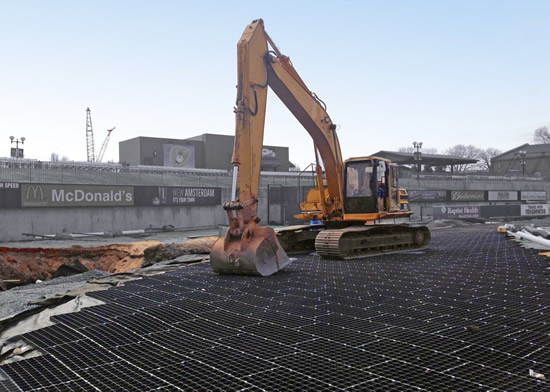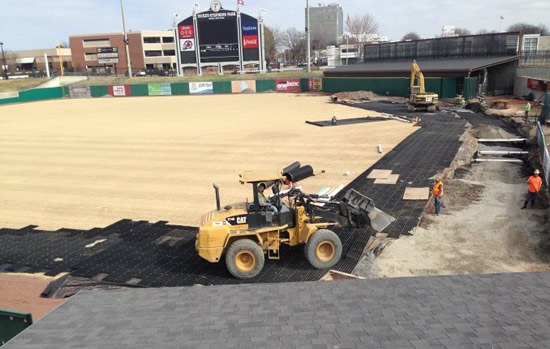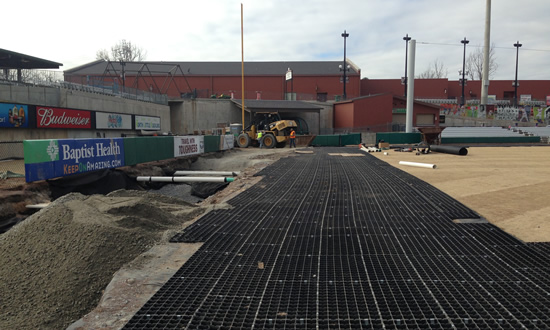

 In North Little Rock, Arkansas, flooding and a drainage system issue led to the development of sinkholes in a minor league baseball field. Engineers utilized polymeric construction mats for immediate construction activity safety and efficiency.
In North Little Rock, Arkansas, flooding and a drainage system issue led to the development of sinkholes in a minor league baseball field. Engineers utilized polymeric construction mats for immediate construction activity safety and efficiency.
SINKHOLES ON THE DIAMOND
Dickey Stephens Park is the home of the Arkansas Travelers, a AA affiliate of Major League Baseball’s Los Angeles Angels of Anaheim. In early 2016, the club found its field crumbling. Jordan Bontke of KATV in Little Rock interviewed an engineering professor from the University of Arkansas – Little Rock to learn more about the issues at the park.
Dr. Jeffrey Connelly cited multiple factors in evaluating the field of play. The park’s near proximity to the Arkansas River and the field being below the surrounding road level placed an above-average level of water directly beneath the ballfield. Furthermore, on-going failure of the French drainage system led to soil and water being pumped out from belowground. As the soil was pumped away, the remaining soils weakened to the point of collapse.
The problem had actually persisted for years but became too glaring to ignore any longer in 2016. Minor patches were not enough.
The geotechnical issues challenged not only the safety of the field for future play but the ability of construction equipment and personnel to safely repair the site.
Polymeric construction mats gave the team a way to stabilize the area, improve drainage, add proper fill, and be confident in the field’s long-term integrity.
RELATED: Interview: Lighter, Stronger, More Sustainable Construction Mats
GEOTERRA CONSTRUCTION MATS
GEOTERRA® Mats were installed to allow heavy vehicle and equipment access in and around the repair site. Manufactured by Presto Geosystems, these polymeric mats are extremely light—about 10% the weight of other polymats—but provide as much strength or more than significantly heavier mats. They improve weak soils, redistributing loads so effectively that heavy equipment can operate on top of them. The quick, secure manner in which the panels lock together enables them to be arranged to meet the differing alignments of construction sites.
The GEOTERRA and GEOTERRA GTO series have been used for more than a decade for construction staging, site access, security for sinkhole repair, oil and gas access roads, and much more.
In Little Rock, the construction mats supported front end loaders, hauling trucks, track hoes, and other vehicles. The month-long repair involved more than 250 trucks entering the site to deliver fill, piping, and other equipment.
Presto notes that high-strength HP270 geotextile was installed as an underlay for the GEOTERRA construction mats to provide soil separation support during heavy rains.
The contractor on site—Diamond Construction—reportedly saved half of the polymeric construction mats for future reuse. This shows how GEOTERRA provides users not just a functional and safe solution but a sustainable one. Construction waste is substantially reduced.
Learn more about GEOTERRA at www.prestogeo.com.
Presto would like to recognize the work of D. Chris Wilbourn, PE, SE, CFM, Chief Engineer (City of North Little Rock) for the Traveler’s ballfield sinkhole repair leadership and project information sharing. Darragh Company supplied the materials.
The original project story from Presto Geosystems, with a few additional details, can be found here (PDF)












So who was the professor? why no credit? who was the project engineer? i doubt it was the City.
How was the sinkhole repaired? how was the Geoterra matting used as permanent installation?
John – The professor interviewed by the local Little Rock media was Dr. Jeffrey Connelly. (Cited in the story.) Chris Wilbourn is the only engineer I know of directly credited to the work, though I do know from local media stories that the city and club consulted with at least one firm along the way. If you scroll to the very bottom of the story, there is a link to the original PDF on which Geosynthetica’s story is based. Presto has included a few more details there. Our understanding is that the sinkholes were the development of soil being continually stripped from underground by a failed drainage system. The replacement of some piping and proper filter media around the pipe system plus better fill has been the solution. That’s as much as I know of the project today.
I’ll look at my wording. I did not mean to imply that the Geoterra mats are permanently on site. They enabled safe, stable access around the critical zones so heavy equipment could be used without further soil collapse that would put workers at risk. The long-term solution is the piping and drainage works. The immediate solution was the use of polymeric mats for site support and safety. (Half of the mats were saved for reuse by the contractor.) I apologize for any confusion I may have caused on that point.
As for your additional comment (not posted here), we do screen comments rather than let them post in real time. There is otherwise a lot of spam added to sites. As a protection for our readers from viruses and trojan horse links, we evaluate all comments before adding them.
Thank you for the note. Perhaps the geosynthetics community will cross paths with The Sutton Group on a project one of these days? (Slope stability/repair, perhaps?) Also, do you interact with the Association of Geohazard Professionals (AGHP) at all? http://www.geohazardassociation.org